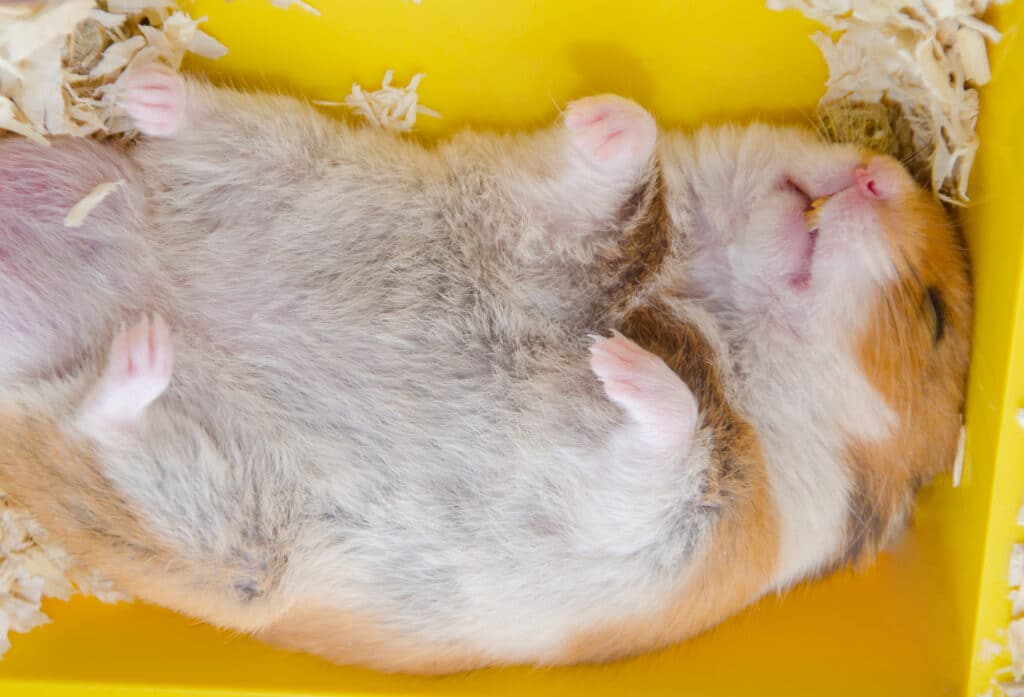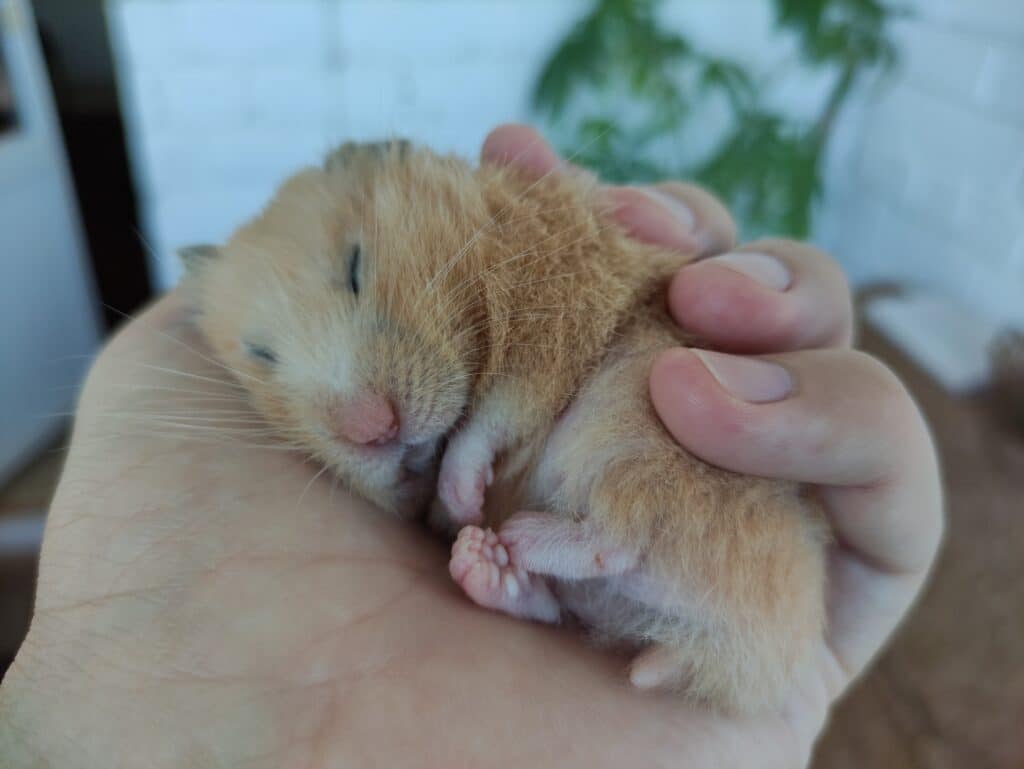Our bodies are extraordinarily amazing at adapting to changes in the environment. When it is too hot, our bodies start sweating to cool us down; when it is too cold, our bodies start burning fats to produce heat.
Just like humans, other animals have their own way of coping with extreme weather conditions. For example, when winter approaches, and it starts getting cold and difficult to find food, animals like bears eat a lot to increase the fat reserves in the body and go into hibernation. But bears are not the only animals that hibernate. There are many other animals that do the same (Source: Tree Hugger).
But what about hamsters? Do hamsters hibernate? Is it dangerous for your hamster to hibernate? What can you do to bring your hamster out of hibernation? Find answers to all these questions in this blog post. But before you find out the answers to all these questions, let’s first look at the basics of hibernation so that it becomes easier to understand why hamsters hibernate.
Dormancy
What is dormancy?
Dormancy is a phase in the life of an organism where all physical activities, growth, and development are halted temporarily, and the metabolism is reduced tremendously to survive in strenuous conditions (Source: Wikipedia). Dormancy can occur either after these strenuous conditions have started (Consequential dormancy) or even before (Predictive dormancy).

Types of Dormancy
1. Hibernation
What is hibernation?
Hibernation is a long period of inactivity which helps animals survive in unfavorable conditions like harsh weather and limited access to food. Before the onset of winter, some animals prepare for hibernation by eating as much as possible. This helps them build up the fat reserves in their bodies, which will serve as the major source of energy during winter months.
Once winter starts, these animals move to a safe place and enter into hibernation. In this state, their body functions are drastically slowed down or, at times, even halted. So, the amount of energy the body needs for survival is reduced significantly.
During hibernation, an animal’s breathing, heart rate, and blood flow are slowed down tremendously, its body temperature goes down, and it wouldn’t make any movements. So, you may mistake a hibernating animal for being dead.
You may think that hibernation makes an animal a sitting duck for predators. But a hibernating animal doesn’t make any sound or movement and gives off less scent. So, it would be very difficult for a predator to find it. It is nature’s way of helping animals survive when conditions become harsh.
Animals can take up to an hour to wake up from hibernation. They can wake up several times during hibernation to change location, eat, or poop (Source: Herts and Middlesex Wildlife Trust).
Hibernation can be classified into two types:
Obligate hibernation
In this type of hibernation, animals enter hibernation spontaneously every year in the winter. Obligate hibernation is seasonal and doesn’t depend on other factors like temperature and availability of food.
Obligate hibernation has traditionally been called ‘Hibernation’ because the body temperatures drop to an extent where they are almost equal to the air temperature, and the respiration and heart rate slow down drastically. Today, obligate hibernation is referred to as ‘True Hibernation.’
Some animals that undergo obligate hibernation include some species of squirrels, European hedgehogs, mouse lemurs, some other rodents, and some insectivores (Source: Wikipedia).
Torpor or Facultative hibernation
Like hibernation, torpor is also a period of reduced physiological activity – Reduced body temperatures, metabolic rate, and heart rate.
Even though torpor sounds similar to hibernation, it doesn’t last as long as hibernation, and animals enter and leave torpor more easily than hibernation. Torpor can last hours to days. You can consider hibernation as an extended torpor.
Unlike hibernation, torpor is not seasonal. It is involuntary, and animals enter it only as a response to the conditions becoming too harsh for survival, like low temperatures and lack of food. It ends when the conditions improve.
Hibernation is where animals spend the entire winter in a state of inactivity, where their body temperature, breathing, heart rate, and metabolism are slowed drastically. But there are also organisms that enter other states of inactivity when conditions become unfavorable for survival. These other states of inactivity are:
2. Brumation
Brumation is also similar to hibernation in the sense that it is an extended state of very minimal activity to conserve energy. But while hibernation is exhibited by endotherms (organisms like animals and birds that can regulate their body temperatures), brumation is exhibited by ectotherms (organisms like reptiles, amphibians, and fish that cannot regulate body temperatures). Like hibernation, brumation is also triggered by a reduction in temperature and daylight hours.
The body temperature of ectotherms depends on the environment. So, as it gets colder, their body temperature goes down, and with it, their metabolic rate goes down too. Hence, they become more sluggish and unable to hunt. Therefore, they enter brumation to conserve energy.
Brumation can last between one to nine months.
3. Diapause
While animals undergo hibernation (and torpor) and reptiles undergo brumation, insects undergo diapause. Unlike the other processes mentioned above, diapause does not slow down the physiological activity of an insect. Instead, it is like hitting a pause button on an insect’s life. They stop aging for some time.
Like hibernation and brumation, diapause, too, occurs as a response to unfavorable environmental conditions. Diapause interrupts an insect’s development so that it can synchronize its life cycle with good weather conditions.
Diapause can occur during any phase of an insect’s life cycle, like embryo, larva, pupa, or adult.
4. Aestivation
Aestivation is another type of dormancy. But unlike all the processes discussed above, aestivation is triggered by an increase in temperature rather than a decrease in temperature. When it becomes too hot and dry, aestivation kicks in, slowing the organism’s metabolic rate and preventing it from drying out. Aestivation is seen in fish and some invertebrates.
Now that we know the different types of dormancy let’s get to the real question – Do hamsters hibernate?
Do hamsters hibernate?
To be precise, hamsters don’t undergo hibernation; they undergo torpor. It is a shortened form of hibernation. But its effects are the same as hibernation. So, it is often customary to use the term ‘hibernation’ to refer to torpor. To refer to hibernation (not torpor), the term ‘True hibernation’ is used. From here on, the same approach will be used in this blog post as well.
The answer to the question (Do hamsters hibernate?) depends on the species of hamster you have.
Syrian hamsters have evolved to survive in arid areas where some nights can get colder than others. At such times, they start hibernating to conserve energy and wake up when it is warm once again. So, Syrian hamsters are more likely to hibernate if the temperature starts going down.
On the other hand, dwarf hamsters, like the Winter White hamsters, have evolved to survive in colder climates. So they may not start hibernating so quickly.
Why and when do hamsters hibernate?
As explained above, torpor is triggered by environmental pressures rather than seasonal changes. But what causes torpor in your hamster depends on his species.
For example, some hamsters enter hibernation if it’s too cold for just a day. Some hamsters enter hibernation only if the cold temperature lasts for more than a month.

The type of hibernation a hamster can undergo also depends on his species. For example, the European hamster, which is larger than pet hamsters, undergoes true hibernation. It hibernates for several months between October and March. It can store up to 65kg of food in anticipation of winter. Then, once it starts hibernating, it wakes up every five to seven days to eat the stored food. Find more information about different types of hamsters in this blog post.
However, on the contrary, pet hamsters don’t undergo true hibernation. They undergo torpor. For example, pet dwarf hamsters undergo hibernation, not every season, but only if something happens that can affect their survival (Source: PetMD). So, what can cause your pet hamster to hibernate?
Pet hamsters can hibernate if one or more of the following scenarios occur:
- Temperature falls below 18°C or 65°F and remains so for a day or more
- There isn’t sufficient water and/or food supply
- There isn’t sufficient bedding material to burrow into and keep themselves warm (After all, that’s how wild hamsters keep themselves warm)
- It is dark for more than 12 hours a day
How to find out if your hamster is going to go into hibernation?
If any of the above scenarios occur, there is a chance that your hamster could go into torpor. If your hamster is going to go into torpor, you will observe one or more of the following symptoms:
- Your hamster will start hoarding and stashing food. Animals prepare for hibernation by eating a lot of food and increasing the fat reserves in their bodies.
- Your hamster will start becoming lethargic and lazy. Hibernation is all about conserving energy by slowing the metabolic rate, breathing, heart rate, and blood flow. So, if your hamster is about to begin hibernation, his metabolic rate will slow down, and he will start becoming lazy.
- When it is too cold, our muscles relax and contract. This involuntary movement reflects as shivering and warms our body. If it is too cold for your hamster and he is about to go into hibernation, he might start shivering.
Is hibernation bad for hamsters?
For animals that undergo ‘True hibernation,’ hibernation can be helpful because they do it every season, normally in winter. So, they eat a lot of food before going into hibernation. This stocks their body with the necessary fats that help them survive the winter.
But pet hamsters can enter hibernation pretty quickly if the temperature drops below 18°C suddenly. So, they may not have enough time to eat a lot of food and increase the fat reserves in their body. Therefore, going into hibernation can cause malnutrition, especially if it lasts for more than 24 hours.
Moreover, hamsters may not drink any water during hibernation. This can also cause dehydration, leading to a host of other problems after they wake up.
So, even though hibernation can be a great way for your hamster to survive cold temperatures, it can also impact his health adversely.
How to prevent hibernation in hamsters?
As the saying goes, “Prevention is better than cure.” So, instead of reviving a hamster that has already entered hibernation, it is a better strategy to prevent him from hibernating in the first place.
So, how do you prevent your hamster from hibernating?
- Make sure that you keep the room, hamster’s cage, and hamster warm. This blog post can help you with that – How to keep your hamster warm?
- Provide a sufficient amount of varied diet to your hamster (Also read: What can hamsters eat? & What can hamsters not eat?). In colder temperatures, feed your hamster food items that contain healthy fats, like nuts, seeds, etc., because fats keep the body warm in winter. Some types of fats can also burn and release energy and heat to keep the body’s core warmer than the environment in winter. Remove uneaten food items within 24 hours.
- Keep fresh water for your hamster to drink every day.
- Provide your hamster with sufficient bedding. Also, provide soft cloth and tissues which your hamster can use to create a cozy warm nest in his hideout. This can help your hamster keep himself warm even if the room is cold.
- Physical activity can help keep the body warm. So, play with your hamster regularly.
- Make sure that your hamster’s cage gets bright light for at least 12 hours a day.
Until now, we have seen what hibernation is, if hamsters hibernate, and how to prevent hibernation. But what if you are reading this blog post too late? What if your hamster has already started hibernating? How can you know that your hamster is not dead and he is just hibernating? If your hamster is indeed hibernating, how do you bring him out of hibernation? Keep reading to find out.
How to find out if your hamster is dead or if he is just hibernating?
As a hamster owner you may be devastated if you find your hamster still and lifeless all of a sudden, especially if your hamster did not display any signs of sickness previously. You may think that he is dead.
But do not write your hamster off as dead just because his body feels too cold to the touch or his eyes are open. After all, body heat is not a reliable indicator of life and hamsters can hibernate with their eyes completely closed, half closed, or open. So, first check for signs of life. The following steps can help you in this regard.
- First check the temperature in your hamster’s cage. Is it less than 18°C? Then, it is highly probable that your hamster is hibernating.
- Next, check for any signs of breathing. This can be a pretty tricky one because hamsters don’t breathe that much while hibernating. They may breathe only a couple of times a minute. So, your hamster’s breathing will be very slow and can be easy for you to miss. But luckily, there are two tricks you can use to make sure that your hamster is breathing: i) Observe your hamster’s whiskers. If he is breathing, regardless of how slow it is, his whiskers will move, albeit only very slightly. ii) Take a mirror and keep it in front of his face. When the air he breathes out comes in contact with the mirror, the mirror will fog, at least slightly (Source: Squeaks and Nibbles).
- Next, check your hamster’s heartbeat. Even if it is too faint, if you can detect a heartbeat, then he is definitely not dead; he is just hibernating. During hibernation (torpor), a hamster’s heartbeat can slow down from 400 beats/minute to 5 – 10 beats/minute (Source: PubMed). So, you must be very careful and vigilant while checking for his heartbeat.
- The final step is to stretch your hamster’s limbs gently. Stretching them will be more difficult than normal but not extremely difficult. On the other hand, if he is dead, rigor mortis would kick in. Then his body will become very stiff, like a board, and bending his limbs will be very difficult.
How to get your hamster out of hibernation?
Ok, now you have confirmed that your hamster is indeed hibernating. What should you do to bring your hamster out of hibernation?
What you should do to bring your hamster out of hibernation depends on how long your hamster has been hibernating.
Has your hamster been hibernating only for a few hours? Then do the following to bring him out of hibernation.
- Increase the room temperature and brightness gradually. A temperature of more than 18°C (preferably 20°C) is necessary. If possible, move the hamster’s cage to a warmer room.
- If your hamster doesn’t wake up within a few hours, you can pick him up and cup him with both your hands and let the warmth from your hands warm him up.
- You can also gently massage him to increase blood circulation.
- You can wrap him up in a warm cloth. Make sure that the cloth isn’t too hot.
If your hamster has been hibernating for less than a day, the steps above should be enough to bring him out of hibernation.
Once your hamster gets out of hibernation and starts moving, give him warm milk through a medicine dropper. This can help warm his body from the inside.
You can also give him some water with electrolytes to hydrate him since hibernation could have dehydrated him.
But the above steps only work if your hamster has been in hibernation for less than a day. If your hamster has been in hibernation for more than a day, then dehydration and malnutrition can occur.
So, once you bring your hamster out of hibernation, water and food have to be administered carefully since your hamster cannot consume too much of either of them. You should gradually increase both. Therefore, it is better to schedule a visit to a vet if your hamster has been in hibernation for more than a day. A vet can inspect your hamster. He can give fluids and nourishment to your furry friend and advice you on how to get your hamster back to normal.



